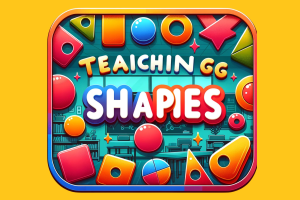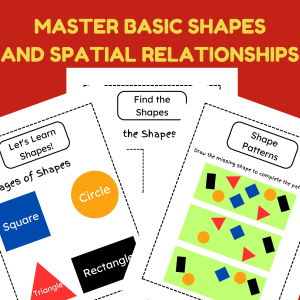Understanding shapes is a fundamental aspect of early childhood education. Shapes are all around us, from the wheels on our cars to the signs on our streets. Teaching basic shapes to Pre-K and Kindergarten students lays the groundwork for developing their cognitive and motor skills. Whether you’re a teacher or a parent, this guide will help you introduce and reinforce the concept of shapes in a fun and engaging way.
INTRODUCTION

Shapes form the basis of our visual understanding and play a crucial role in early childhood education. By recognizing and identifying shapes, young children develop essential skills such as spatial awareness, problem-solving, and even early math abilities. But how do you make learning about shapes interesting and memorable for Pre-K and Kindergarten students? The answer lies in combining creativity with structured learning.
In this article, we will explore various strategies, activities, and tips to effectively teach basic shapes. From circles to triangles, we’ll cover it all, ensuring that your little learners grasp the concept of shapes with enthusiasm.
WHY TEACHING SHAPES IS IMPORTANT

Shapes are more than just geometric figures; they are the building blocks of our world. Teaching children to recognize and understand shapes helps them develop critical thinking and observational skills. Here’s why teaching shapes is essential:
- Foundation for Geometry: Learning shapes is the first step towards understanding geometry.
- Spatial Awareness: Shapes help children understand spatial relationships and how objects fit together.
- Early Math Skills: Recognizing shapes is a precursor to learning about numbers, patterns, and measurements.
- Problem-Solving: Identifying and differentiating shapes enhances problem-solving abilities.
STARTING WITH THE BASICS
CIRCLE: THE FRIENDLY SHAPE
The circle is one of the easiest shapes for young children to recognize and draw. It’s everywhere—from the wheels on a toy car to the moon in the sky.
Activities to Teach Circles:
- Circle Hunt: Go on a circle hunt around the house or classroom. Find and name all the circular objects you can see.
- Drawing Circles: Provide children with various circular objects (like bottle caps) to trace.
- Circle Songs and Rhymes: Incorporate fun songs and rhymes that emphasize the circular shape.
SQUARE: THE STABLE SHAPE
Squares are all about balance and equality, with four sides of equal length. They are commonly found in everyday items such as windows, tiles, and picture frames.
Activities to Teach Squares:
- Shape Sorting: Mix different shapes and have children sort out all the squares.
- Building with Blocks: Use square building blocks to create simple structures.
- Square Art: Encourage children to make artwork using only square shapes.
ADVANCING TO OTHER SHAPES
TRIANGLE: THE DYNAMIC SHAPE
Triangles, with their three sides and three angles, are dynamic and interesting shapes for children to learn. They can be seen in various objects like slices of pizza or road signs.
Activities to Teach Triangles:
- Triangle Collage: Create a collage using cut-out triangles of different sizes and colors.
- Triangle Treasure Hunt: Look for triangle-shaped objects indoors and outdoors.
- Triangle Puzzles: Use puzzles that incorporate triangle shapes to build cognitive skills.
RECTANGLE: THE PRACTICAL SHAPE
Rectangles are everywhere, from doors to books and mobile phones. They have two pairs of equal sides and are essential for teaching about parallel lines and right angles.
Activities to Teach Rectangles:
- Shape Comparison: Compare rectangles with squares to highlight the differences.
- Building Rectangles: Use rectangular blocks to build and explore structures.
- Rectangle Drawings: Draw everyday objects that are rectangular in shape.
COMBINING SHAPES FOR CREATIVITY
Once children are familiar with basic shapes, it’s time to get creative by combining them. This not only reinforces their understanding but also encourages them to think outside the box.
Creative Shape Activities:
- Shape Animals: Create animals using different shapes. For example, a house made from a square and a triangle.
- Shape Stories: Tell a story using shapes as characters.
- Shape Crafts: Make fun crafts using a combination of circles, squares, triangles, and rectangles.
TIPS FOR TEACHING SHAPES
USE REAL-LIFE EXAMPLES
Incorporate real-life examples of shapes into your teaching. This helps children connect shapes with their environment and understand their practical uses.
MAKE IT INTERACTIVE

Interactive activities such as shape hunts, drawing, and puzzles keep children engaged and make learning more effective.
REPEAT AND REINFORCE
Repetition is key to learning. Regularly revisiting shapes and their properties helps reinforce knowledge and ensures retention.
USE TECHNOLOGY
Incorporate educational apps and online resources that focus on shapes. Interactive games and videos can make learning shapes more exciting.
INTEGRATE OTHER SUBJECTS
Integrate shapes into other subjects such as art, science, and even physical education. This multidisciplinary approach makes learning more comprehensive and fun.
CONCLUSION
Teaching basic shapes to Pre-K and Kindergarten students is a rewarding experience that lays a strong foundation for their future learning. By incorporating a variety of activities, real-life examples, and interactive methods, you can make the process enjoyable and effective. Remember, the key to success is to make learning shapes a fun and engaging adventure for your little learners.
Shapes are all around us, and by unlocking the world of shapes, you are opening up a new realm of understanding for young minds. So, gather your teaching materials, get creative, and embark on this exciting journey of shape discovery!
With the right approach, teaching shapes can be an enjoyable and fulfilling task. So, start today and watch your students’ eyes light up as they recognize and create the shapes that make up their world.
Frequently Asked Questions (FAQs) about Teaching Basic Shapes to Pre-K and Kindergarten
Why is it important to teach basic shapes to young children?
Answer: Teaching basic shapes to young children is crucial because it helps them develop foundational skills such as spatial awareness, problem-solving, and early math abilities. Shapes are everywhere in our environment, and recognizing them helps children understand the world around them better. It also lays the groundwork for more advanced geometric concepts in later grades.
At what age should children start learning about shapes?
Answer: Children can start learning about shapes as early as 2 to 3 years old. At this age, they can begin to recognize and name basic shapes like circles, squares, and triangles. Formal shape education usually starts in Pre-K (around age 4) and continues into Kindergarten.
What are some effective activities for teaching shapes?
Answer: Effective activities for teaching shapes include shape hunts, drawing and tracing shapes, building with shape blocks, and creating art projects using different shapes. Interactive games, puzzles, and songs that focus on shapes are also highly beneficial for young learners.
How can I make learning shapes fun for my child?
Answer: Make learning shapes fun by incorporating games, songs, and hands-on activities. Use everyday objects to find shapes around the house or classroom. Create art projects, play shape-themed games, and use educational apps that focus on shapes. The key is to keep the activities varied and engaging.
How can I integrate shape learning into other subjects?
Answer: Integrate shape learning into other subjects by using shapes in art projects, incorporating them into storytelling, and finding shapes in nature during science lessons. Shapes can also be used in physical education activities, such as creating obstacle courses with shape-themed stations.
What tools or resources can I use to teach shapes?
Answer: Tools and resources for teaching shapes include shape puzzles, building blocks, educational apps, and interactive games. Books that focus on shapes, printable worksheets, and shape-themed craft supplies are also useful. Online resources such as videos and songs can make shape learning more dynamic.
How can I assess my child’s understanding of shapes?
Answer: Assess your child’s understanding of shapes by observing their ability to recognize and name shapes in various contexts. Use shape-sorting activities, ask them to draw or trace shapes, and have them identify shapes in their environment. Quizzes and interactive games can also help assess their knowledge.
What should I do if my child is struggling to learn shapes?
Answer: If your child is struggling to learn shapes, try using a variety of teaching methods to find what works best for them. Use hands-on activities, real-life examples, and interactive games. Be patient and provide plenty of positive reinforcement. Breaking down shapes into smaller, more manageable parts can also help.
How often should I revisit shape learning with my child?
Answer: Regularly revisiting shape learning is important to reinforce knowledge and ensure retention. Incorporate shape activities into daily routines, such as during playtime or while reading books. Consistent practice and review help solidify understanding.
Are there any online resources or apps that can help with teaching shapes?
Answer: Yes, there are many online resources and apps designed to help teach shapes to young children. Educational websites, videos, and apps offer interactive and engaging ways to learn about shapes. Some popular apps for shape learning include “Shape Builder,” “Toddler Teasers Shapes,” and “PBS Kids Games.”
Can learning shapes help with other areas of development?
Answer: Absolutely. Learning shapes helps with cognitive development, fine motor skills, and visual-spatial awareness. It also enhances early math skills, such as understanding patterns and geometry. Recognizing shapes can improve problem-solving abilities and boost overall academic readiness.
What shapes should I start with when teaching my child?
Answer: Start with basic shapes such as circles, squares, triangles, and rectangles. These shapes are commonly found in everyday objects and are easier for young children to recognize and draw. Once your child is comfortable with these, you can introduce more complex shapes like ovals, hexagons, and stars.
